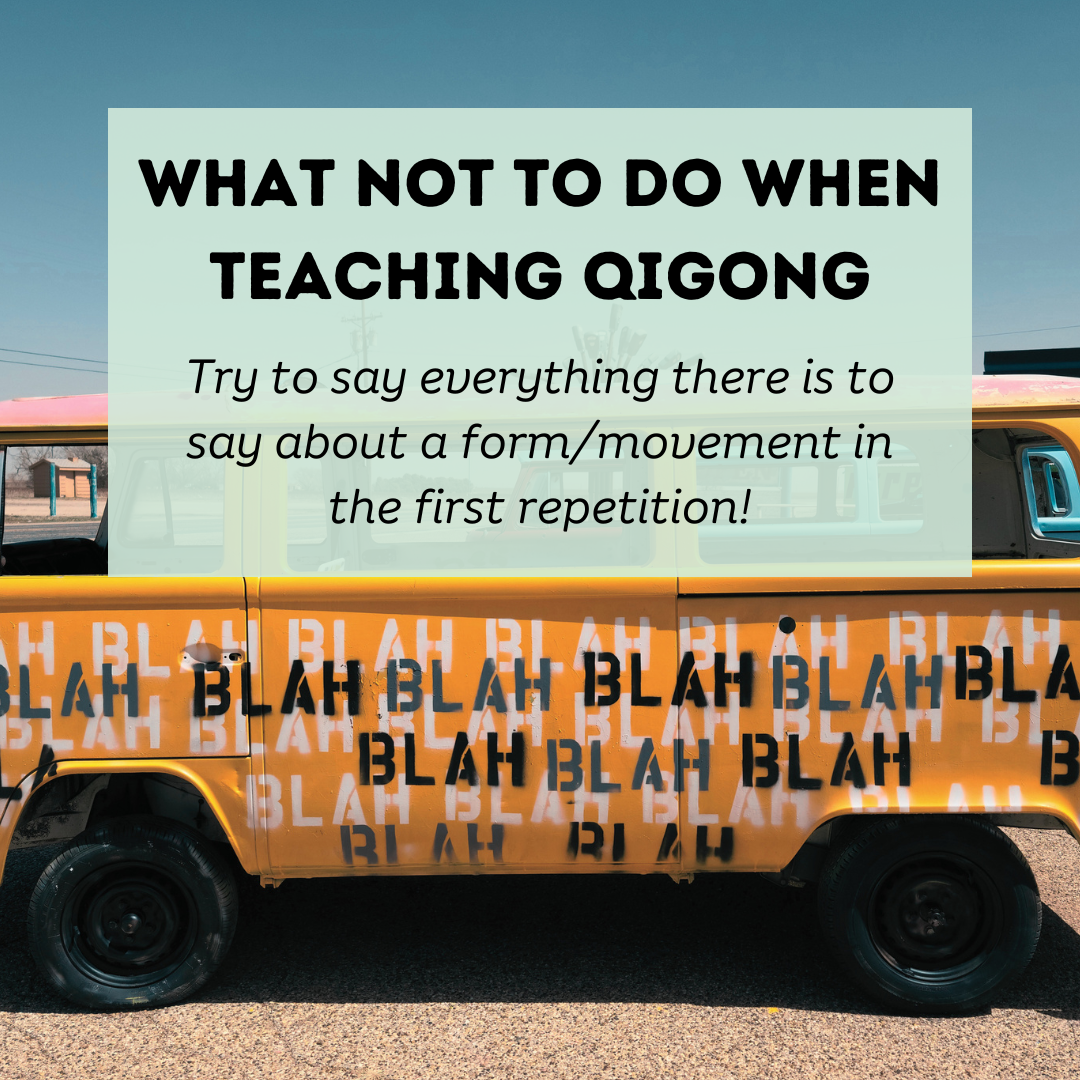Teaching Qigong: 3 Mistakes You Shouldn't Make
Over my years as a Qigong Teacher trainer, I've guided hundreds of students on their journey to becoming proficient Qigong instructors. Through mentoring emerging teachers, I've noticed some common pitfalls and mistakes to avoid in the early days of teaching Qigong.
Qigong has many facets — movement, posture, breath-work, presence, perception, awareness and stillness. There are hundreds, if not thousands, of practices utilized for a variety of purposes. In terms of form and movement, the fundamentals of posture, alignment, and presence are threads woven into all traditions, lineages, and styles.
This brings me to a few things NOT to do when starting on the teaching path.
1. Fidget
Don’t fidget. Students do what you do. If you’re fidgety or distracted your students will emulate this energy. A hallmark of Qigong form and movement is its precision and intentionality—you move in a specific manner with purpose. If you’re lifting your toes when demonstrating your students will likely copy that. If you’re wiggling your fingers or jostling your body in some way that is not part of the form expression your students will do that too.
As a Qigong teacher, one of your essential roles is to serve as an anchor, a grounding force, offering your students a sense of presence and ease.
Another aspect to consider is wearing appropriate clothing. I remember a little while back I bought a new cotton top, it was a lovely loose fit and I thought it would be great to wear when practising Qigong. Nope. It kept riding up and catching on my bra which meant I had to tug it down and adjust it regularly.
It is distracting for you as the teacher and it’s equally distracting for your students.
A few other things to consider to help you avoid the squirm. Your hair. Yep, think about your hair — especially if it’s long. Constantly swiping your hair from your face and eyes will break the flow of your form expression. Jewellery, unsurprising clangy, bangy jewellery is discouraged!! To encourage the flow of Qi, it's better not to wear jewelry during practice, or at least opt for items that are neither tight nor noisy.
There are exceptions to consider, such as the demographics of your students or if you specialize in a particular niche within Qigong. However, in general, fidgeting is something to avoid.
2. Don’t overload your verbal cues
Don’t try and say everything there is to say about the expression of a particular Qigong form or movement in the first repetition!
It’s common for new Qigong teachers to fail to get going in their demonstration and expression because they’re blah blah blah-ing. Just get going!
As I mentioned above, your students will do what you do. Rather than try and explain the movement or form with a bunch of words say a couple of basic verbal cues and get yourself into the flow of demonstrating. You can say more as the practice unfolds. In an in-person class, you'll be observing your students and their movements, adding more verbal guidance based on what you see.
If you’re demonstrating the form or movement correctly yourself and you’re not fidgeting then very quickly your students will be emulating you and the need to be chatty-Cathy in your instruction is drastically reduced!
When teaching Qigong, we aim to use the fewest and most effective words to describe what we want our students to express. Just like in Qigong practice, less is more.
3. Go too slow
While Qigong emphasizes slow, deliberate movements, demonstrating too slowly can prevent students from getting into flow. This is another reason why it’s important not to over-cue at the beginning of a form. Just get going.
When you go too slow the expression of form is often disjointed, as the teacher you need to get into flow yourself. It’s one of the easiest ways to help your students feel comfortable and at ease. Experiences of Qi come from presence and flow, which is ultimately what we’re seeking to facilitate for our students.
Depending on the audience, there might be instances where going too slow results in the disengagement of your students or causes distraction and restlessness. This is particularly true for people very new to Qigong and the nature of its slow, precise and intentional movements. People who are anxious or prone to overthinking often find it challenging to enjoy Qigong if the expression and demonstration are too slow, clunky, or incoherent. In some instances, we might even speed up our pace from our usual expression to help facilitate these types of students.
Once you find your flow as the teacher and notice your students following suit, encourage them to discover their own rhythm. This helps them find what feels right and allows them to truly experience the magic of Qi!
My point about going too slow is only relevant from the teaching perspective. In your own personal practice of Qigong, you can express the movements and forms at a pace that feels magical to you! In my experience, it is easier to feel Qi and to develop one’s sensitivity to Qi when moving slowly with mindfulness and presence.
For aspiring Qigong teachers, personal practice is the KEY to becoming proficient. When you fully embody the form, you can teach from a place of authenticity and experience.
Allow me to mentor you and unlock the secrets to effectively teaching Qigong. The next in-person Qigong Teacher Training will be on the Sunshine Coast, Australia in July 2024.
Online training is available too, join a group or the 1:1 program now.





